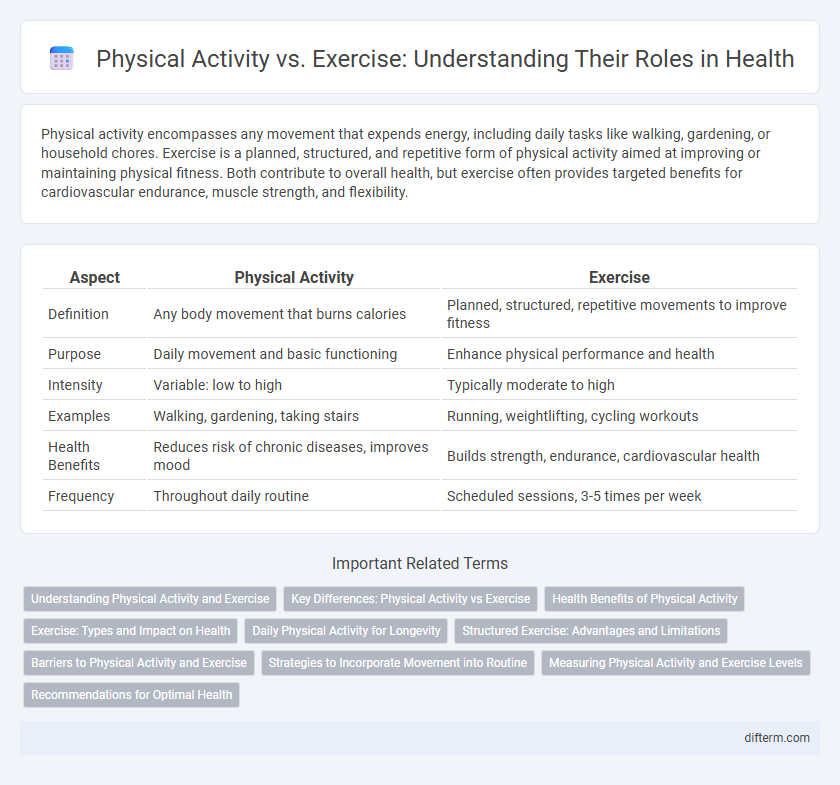Physical activity encompasses any movement that expends energy, including daily tasks like walking, gardening, or household chores. Exercise is a planned, structured, and repetitive form of physical activity aimed at improving or maintaining physical fitness. Both contribute to overall health, but exercise often provides targeted benefits for cardiovascular endurance, muscle strength, and flexibility.
Table of Comparison
| Aspect | Physical Activity | Exercise |
|---|---|---|
| Definition | Any body movement that burns calories | Planned, structured, repetitive movements to improve fitness |
| Purpose | Daily movement and basic functioning | Enhance physical performance and health |
| Intensity | Variable: low to high | Typically moderate to high |
| Examples | Walking, gardening, taking stairs | Running, weightlifting, cycling workouts |
| Health Benefits | Reduces risk of chronic diseases, improves mood | Builds strength, endurance, cardiovascular health |
| Frequency | Throughout daily routine | Scheduled sessions, 3-5 times per week |
Understanding Physical Activity and Exercise
Physical activity encompasses all bodily movements that increase energy expenditure, including daily tasks like walking and gardening, while exercise is a subset of physical activity that is planned, structured, and repetitive, aimed at improving or maintaining physical fitness. Understanding the distinction clarifies that any movement contributes to health benefits, but targeted exercise enhances cardiovascular health, muscle strength, and flexibility more effectively. Health guidelines recommend at least 150 minutes of moderate-intensity physical activity or 75 minutes of vigorous exercise weekly for optimal well-being.
Key Differences: Physical Activity vs Exercise
Physical activity encompasses all bodily movements produced by skeletal muscles that result in energy expenditure, including daily tasks like walking or gardening, whereas exercise is a subset of physical activity defined by planned, structured, and repetitive movements aimed at improving or maintaining physical fitness. Exercise targets specific health outcomes such as cardiovascular endurance, muscle strength, and flexibility through consistent routines, while physical activity includes unstructured movements that contribute to overall energy burn. Understanding these distinctions helps optimize health interventions by promoting regular exercise for fitness goals alongside general physical activity for broader health benefits.
Health Benefits of Physical Activity
Physical activity encompasses all bodily movements that increase energy expenditure and improve cardiovascular health, whereas exercise is a structured, repetitive form of physical activity aimed at enhancing fitness. Regular physical activity reduces the risk of chronic diseases such as Type 2 diabetes, hypertension, and obesity, while improving mental health by decreasing symptoms of depression and anxiety. Studies show that engaging in at least 150 minutes of moderate-intensity physical activity per week significantly boosts overall health and longevity.
Exercise: Types and Impact on Health
Exercise encompasses various types such as aerobic, strength training, flexibility exercises, and balance workouts, each targeting specific health benefits. Aerobic exercise improves cardiovascular health by increasing heart rate and oxygen consumption, while strength training enhances muscle mass, bone density, and metabolic rate. Regular engagement in these exercises reduces risks of chronic diseases like diabetes, hypertension, and obesity, promoting long-term well-being and functional independence.
Daily Physical Activity for Longevity
Daily physical activity, including walking, gardening, and household chores, significantly contributes to increased longevity by improving cardiovascular health, enhancing muscle strength, and reducing the risk of chronic diseases. Unlike structured exercise routines, physical activity integrated into daily life encourages consistent movement without requiring dedicated time or equipment. Studies show that people engaging in moderate daily physical activity experience lower mortality rates and improved quality of life across all age groups.
Structured Exercise: Advantages and Limitations
Structured exercise offers targeted benefits such as improved cardiovascular health, muscle strength, and endurance through planned routines like weightlifting or aerobic classes. It allows for progress tracking and goal setting, enhancing motivation and consistency. However, its limitations include potential risk of injury from improper form and reduced enjoyment for those who prefer spontaneous or social physical activities.
Barriers to Physical Activity and Exercise
Barriers to physical activity and exercise often include lack of time, insufficient motivation, and limited access to facilities or safe environments. Psychological factors such as fear of injury, low self-efficacy, and social support deficits also significantly impede regular engagement. Addressing these barriers through tailored interventions, community programs, and policy changes can enhance overall physical activity levels and improve public health outcomes.
Strategies to Incorporate Movement into Routine
Integrating physical activity into daily routines can be achieved through simple strategies such as taking brisk walks during breaks, using stairs instead of elevators, and scheduling short movement sessions throughout the day. Exercise-focused approaches include setting specific workout goals, joining group classes, or using fitness apps to track progress and maintain motivation. Combining both spontaneous physical activity and structured exercise effectively promotes overall health and reduces the risk of chronic diseases.
Measuring Physical Activity and Exercise Levels
Measuring physical activity involves tracking all bodily movements that increase energy expenditure, including daily tasks and spontaneous activities, whereas exercise refers to planned, structured, and repetitive movements aimed at improving fitness. Tools such as accelerometers, pedometers, heart rate monitors, and self-report questionnaires are commonly used to quantify both physical activity and exercise levels. Accurate measurement is essential for linking activity patterns to health outcomes and designing effective interventions.
Recommendations for Optimal Health
Engaging in at least 150 minutes of moderate-intensity physical activity or 75 minutes of vigorous exercise weekly enhances cardiovascular health, supports weight management, and reduces the risk of chronic diseases. Incorporating muscle-strengthening exercises on two or more days per week further improves bone density and metabolic function. Consistent adherence to these guidelines from organizations like the World Health Organization (WHO) and American Heart Association (AHA) promotes optimal overall health and longevity.
physical activity vs exercise Infographic

 difterm.com
difterm.com